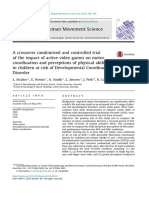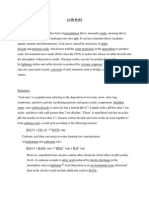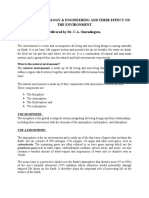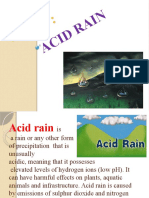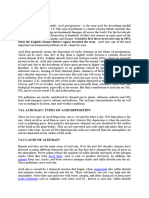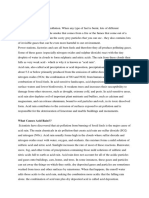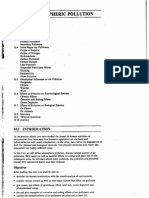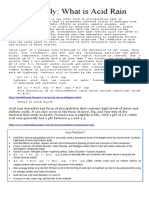1
Final Report: Water Chemistry
Name: Suresh Indika Jayawardhana Ethugal Pedige Student ID: 2021A8004237003
Topic: Acid Rain: cause , effect and what we can do? Abstract
Acid rain can be identified as a major result of air pollution due the natural and anthropogenic activities. Precipitation of a mixture of sulfuric and nitric acids species is called acid rains. Soil acidity, river water acidification and seawater acidification are the major environmental impacts of the acid rains. Acidic water infiltration lowers the pH of the soil and increase the dissolution of mineral which leads to increase heavy metal contents in the groundwater. The impact of major global environmental issues such as acid rain, acid deposition, ozone layer depletion, and the impact of particulate matter on health and the environment is declining. Acidification has been seen throughout the world, such as harmful ecological effects, reduction of aquatic fish reproduction, plant death and irritable growth, accumulation of toxic heavy metals in soil and water, loss of biodiversity (coral and shellfish classes), degraded man-made structures are formed by corrosion of marble and stone and metal structures.
Contents
1 Introduction .................................................................................................................................................... 2 1.1 Wet Deposition ..................................................................................................................................... 3 1.2 Dry Deposition ...................................................................................................................................... 3 1.3 Mechanism of acid rain ......................................................................................................................... 3 1.4 Chemical reactions ................................................................................................................................ 4 2 Effects of Acid Rain....................................................................................................................................... 5 2.1 Effects human Health: - ........................................................................................................................ 5 2.2 Effect on plants eco system ................................................................................................................... 6 2.3 Effects in the natural forest ................................................................................................................... 6 2.4 Effects on Stone Buildings and Monuments in Acid Rain .................................................................... 6 3 Controlling effect of acid rain ........................................................................................................................ 7 4 References ...................................................................................................................................................... 8
2
1
Introduction
Natural resource utilization was increase since the early beginning of human civilization. Especially, with the development of science and technology, resource depletion and waste production has been rabidly increased while polluting the natural environmental phase such as atmosphere water and the land mass. Different type of natural resources was processed and extract the valuable materials and energies by the human. for their benefit. When the life become easier due to the development of science and technology, on the other hand waste production is increased and environmental degradation happens. Acid rain is one of the major effects that occur due to the pollution of the atmosphere. Low pH acidic rainfall which occurs due to the dissolution of acidic gases in the atmosphere is call as acid rains. Damaging the surface water bodies such as lakes, streams and rivers and forests, and the plants and animals that sustained the nature ecosystems which is a home for many habitats including humans is a dark side of the acid rains. However, Rainfall is one of the major factors that control the quality of the human life style. It supplies essential ingredients for living beings. All the living beings are depending on the water cycle which governed by the rainfall on earth mass. The impact of major global environmental issues such as acid rain, acid deposition, ozone layer depletion, and the impact of particulate matter on health and the environment is declining. Acidification has been seen throughout the world, such as harmful ecological effects, reduction of aquatic fish reproduction, plant death and irritable growth, accumulation of toxic heavy metals in soil and water, loss of biodiversity (coral and shellfish classes), degraded man-made structures are formed by corrosion of marble and stone and metal structures. Usually, natural rain is slightly acidic. But, due to the many anthropogenic activities such as industrial
sites, power stations, vehicles, domestics activities as well as natural phenomena’s such as
volcano eruptions, acidic composition of the atmospheric composition is rising and more negative pH rainfalls are reporting from all over the world. Acid rain has a history of centuries not only the last few decades. It increased with the industrial revolution with the higher rates of resource utilization and waste production. one of the largest industrial pollution effects is the acid rain which were reported based on the literature. Acid rain is some time called acid deposition due to the different phases of acid rains such as snowing. There are two types of deposition: 1.
Wet deposition 2.
Dry deposition
3
Figure 1: Acid rain 1.1
Wet Deposition Wet deposition totally depending on the cloud formation. Formation of cloud rain droplets on aerosol particles are the main mechanism of wet deposition(Xia et al., 2022). Wet deposition can be observed as acid rain, snow, sleet and fog, If the acidic molecules with the exhaust gases blown into areas where the weather is wet, the acidic rainfall precipitates on to the land in the form of rain, snow, fog, or mist. After the rain acidic runoff will flow along the land and through ground earth soil layer while disturbing the natural habitats such as plants, animals and microbes. This can lead to land degradation and desertification as well. However, there are some of advantages s of wet deposition. N deposition in tropical rainforests is majorly govern by this wet deposition when it has not a dry period. 1.2
Dry Deposition Deposition of particulate matter (less than PM 2.5) is called as Dry deposition because the dryness of the particles which is the second type of acid rains(Zhou et al., 2021). When the low humidity incorporates with the acidic gas exhausts acidic molecules bond on to dry particulate matter (dust and smokes) floating on the air. Then it starts to fall to the ground due to the higher density through dry deposition, sticking to the ground, buildings, homes, cars, and trees. 1.3
Mechanism of acid rain Oxides of Sulphur, nitrogen and ozone are the primary causes of acid rain for some extent. These elements interact with existing reactions in the atmosphere and cause acid deposition. Natural sources of sulfur pollution are very small, from oceans and volcanic eruptions. Man-made sources of SO2 emissions include coal and petroleum and the burning of various industrial processes. Other sources include the smelting of iron and other metal (Zn and Cu) ores, the production of sulfuric acids, and the activity of acid concentrators in the petroleum industry. The amount of NOx is small compared to SO2, but its contribution to production is increasing acid rain. The degree of acidity is measured by pH value, it is shorthand version of potential hydrogen. Usually, the pH of normal rainwater is lightly acidic; the reason is that water reacts to a slight extent with atmospheric carbon dioxide (CO2) to produce carbonic acid.
4
Lightening in the storm situation will increase the Nitrogen oxide formation and the dissolution in the rain water, which is another course of acidification of the precipitation. 2 N
2
+5O
2
+2H
2
O ------
→
HNO
3
(nitric acid) Figure 2: Nitrogen cycle Rain that has pH value is less than 5.6 is considered as acidic. Some studies have proposed that a pH of 5.0 as a limit of natural contribution. 1.4
Chemical reactions The chemical reaction that produces acid rain involves the contact of SO2, NOx and O3. When pollutants are emitted into the atmosphere by elevated smoke, the SO2 and NOx molecules are trapped in the prevailing air, where they interact with vapors in the presence of sunlight to form sulfuric acid and nitric acid mist. These acids evaporate under high temperature conditions. As the temperature drops, the condensate takes the form of aerosol droplets, which become black, acidic and carbonaceous due to the presence of unburned carbon particles. Figure 3: Sulfur cycle





